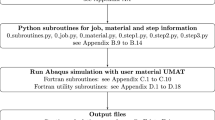A small-scale plastic zone at the point of intersection of microplastic deformation lines is identified. The problem on the plastic zone is reduced to a symmetric elasticity problem for a plane with four tangential displacement discontinuity lines emerging from this point. Two of them are semi-finite, while the other two are of finite length. The exact solution of the problem is found using the Wiener–Hopf method.
Similar content being viewed by others
References
L. T. Berezhnitskii and N. M. Kundrat, “Plastic bands at the tip of a linear rigid inclusion,” Strength of Materials, 14, No. 11, 1502–1505 (1982).
L. T. Berezhnitskii and N. M. Kundrat, “Origin and development of plastic strains in the neighborhood of an acute-angled rigid inclusion,” Materials Science, 19, No. 6, 538–546 (1984).
P. M. Vitvitskii, V. V. Panasyuk, and S. Ya. Yarema, “Plastic strains in the vicinity of cracks and the criteria of fracture. A review,” Strength of Materials, 5, No. 2, 135–151 (1973).
A. A. Kaminsky, A. S. Bykovtsev, L. A. Kipnis, and G. A. Khasin, “Stress intensity at the tips of shear cracks emerging from a point on an elastic plane,” Dop. NAN Ukrainy, No. 1, 56–58 (2005).
B. Noble, Methods Based on the Wiener–Hopf Technique for the Solution of Partial Differential Equations, Pergamon Press, London (1958).
V. V. Panasyuk, A. E. Andreikiv, and V. Z. Parton, Fundamentals of Fracture Mechanics of Materials [in Russian], Naukova Dumka, Kyiv (1988).
V. V. Panasyuk and M. P. Savruk, “Model of plasticity bands in elastoplastic failure mechanics,” Materials Science, 28, No. 1, 41–57 (1992).
V. Z. Parton and P. I. Perlin, Methods of Mathematical Theory of Elasticity [in Russian], Nauka, Moscow (1981).
A. A. Kaminsky and Yu. A. Chernoivan, “Determination of safe static loads for polymeric composites weakened by cracks,” Int. Appl. Mech., 54, No. 4, 384–392 (2018).
A. A. Kaminskii, L. A. Kipnis, and G. A. Khasin, “Study of the stress state near a corner point in simulating the initial plastic zone by slip bands,” Int. Appl. Mech., 37, No. 5, 647–653 (2001).
A. A. Kaminskii, L. A. Kipnis, and G. A. Khasin, “Analysis of the plastic zone at a corner point by the trident model,” Int. Appl. Mech., 38, No. 5, 611–616 (2002).
A. A. Kaminskii, L. A. Kipnis, and T. V. Polishchuk, “Stress state near a small-scale crack at the corner point of the interface of media,” Int. Appl. Mech., 54, No. 5, 506–518 (2018).
A. A. Kaminskii, L. A. Kipnis, and T. V. Polishchuk, “Cottrell crack nucleation condition,” Int. Appl. Mech., 54, No. 6, 642–652 (2018).
A. A. Kaminskii and E. E. Kurchakov, “Influence of tension along a mode I crack in an elastic body on the formation of a nonlinear zone,” Int. Appl. Mech., 51, No. 2, 130–148 (2015).
A. A. Kaminskii and M. F. Selivanov, “Modelling subcritical crack growth in a viscoelastic body under concentrated forces,” Int. Appl. Mech., 53, No. 5, 538–544 (2017).
A. A. Kaminsky, M. F. Selivanov, and Yu. A. Chernoivan, “Kinetics of mode I crack growth in a viscoelastic polymeric material with nanoinclusions,” Int. Appl. Mech., 54, No. 1, 34–40 (2018).
K. K. Lo, “Modeling of plastic yielding at a crack tip by inclined slip planes,” Int. J. Fract., 15, No. 6, 583–589 (1979).
J. R. Rice, “Limitations to the small scale yielding approximation for crack tip plasticity,” J. Mech. Phys. Solids, 22, No. 1, 17–26 (1974).
H. Ridel, “Plastic yielding on inclined slip-planes at a crack tip,” J. Mech. Phys. Solids, 24, No. 5, 277–289 (1976).
M. F. Selivanov, “Slow growth of a crack with contacting faces in viscoelastic bodies,” Int. Appl. Mech., 53, No. 6, 617–622 (2017).
V. Vitek, “Yielding on inclined planes at the tip of a crack loaded in uniform tension,” J. Mech. Phys. Solids, 24, No. 5, 263–275 (1976).
Author information
Authors and Affiliations
Corresponding author
Additional information
Translated from Prikladnaya Mekhanika, Vol. 55, No. 5, pp. 69–77, September–October 2019.
Rights and permissions
About this article
Cite this article
Kaminsky, A.A., Kipnis, L.A. & Polishchuk, T.V. Model of the Plastic Zone at the Point of Intersection of Microplastic Deformation Lines. Int Appl Mech 55, 515–523 (2019). https://doi.org/10.1007/s10778-019-00973-z
Received:
Published:
Issue Date:
DOI: https://doi.org/10.1007/s10778-019-00973-z




